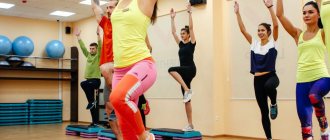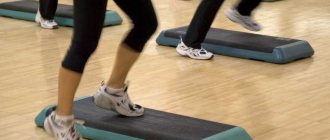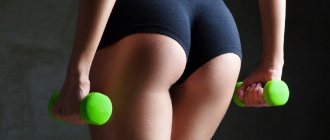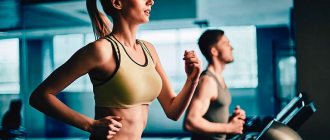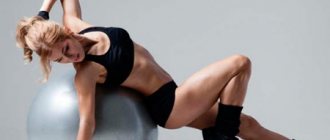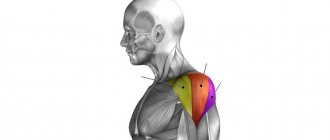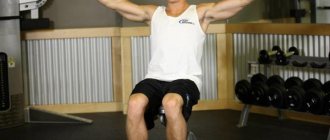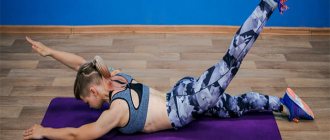The step platform is one of the simplest sports equipment, and it really has a lot of benefits! If your problem areas are below the waist, step aerobics should be one of your favorite and frequently repeated exercises. And then slender legs and elastic buttocks are guaranteed! In addition, step aerobics exercises , like any aerobics, are useful for strengthening the heart and blood vessels and increasing overall tone.
The women's website “Beautiful and Successful” offers its own exercise options.
Steps without changing the leading foot.
The number of counts for which the step is performed is indicated in parentheses. Basic step (4).
This is the simplest basic step, essentially we just get on and off the platform.
- step one foot straight onto the step platform
- step with the other foot directly onto the step platform
- step with the first foot from the step platform
- step with the second foot from the step platform
V-step (4). Almost a complete analogue of the corresponding step in classical aerobics.
- step with one foot to the corner of the step platform (if we go from the left foot, then to the left corner, from the right, to the right)
- step with one foot to the opposite corner of the step platform
- step with the first foot from the step platform
- step with the second foot from the step platform
Over the top or Over (4). The name of this step is translated as “through” or “through the top.” During its execution, we move across the platform to the other side.
- step with one foot sideways onto the step platform.
- step with the second foot onto the step platform and simultaneously turn backwards
- step back with the first foot from the step platform
- step with the second foot from the step platform back
Straddle (8). Step no is performed as follows: we climb onto the step platform, alternately place our feet on the floor on one side and the other of the platform, climb onto the platform again, and return to the starting position.
- step with one foot sideways onto the step platform
- step with the other foot onto the step platform (we stand facing the short edge of the platform)
- we lower one leg from the step platform on one side
- we lower the second leg from the step platform on the other side
- return the first leg to the step platform
- return the second leg to the step platform
- we go down from the platform with the first foot (we must go down to the same place from where we started moving)
- we go down from the platform with the second foot (put it to the first)
Turn step (4). This is the same basic-step, only we descend from the step platform not backwards, but sideways.
- step with one foot onto the step platform
- step with the other foot onto the step platform and turn your back to the short edge of the platform (from which leg we start the movement, we turn our back to the opposite edge)
- we go down with one foot from the platform from the short edge
- we go down with the other foot from the platform from the short edge
Features and benefits for the body
Step aerobics in fitness is a low-impact workout, that is, the heart rate during it is 60% of the maximum. The movements are not too intense; they are performed for 40–60 minutes in the same rhythm. During classes, a step platform is used, the height of which is changed depending on the person’s preparation and the required load. The training is suitable for both beginners and advanced athletes.
Step aerobics classes provide a soft, gentle load on the joints, because this sport originated as a therapeutic one. Its founder, Jean Miller, worked with an empty box in 1989 on the advice of an orthopedist to restore her knee. In the process, she came up with new exercises that were included in the first basic complex.
Sports exercises with a step platform are combinations of rhythmic steps that differ in complexity and intensity. The workout begins with a warm-up, then the load increases. There are no breaks during classes. The buttocks and legs are best worked on, but many balance routines include exercises for the arms and abdomen. Today there are several types of step aerobics:
- Basic Step – complexes for beginners, only basic steps;
- Advanced Step - advanced level, complex combinations;
- Step-combo – high intensity, lots of coordination exercises;
- Dance Step – dance movements with step;
- Double Step – training with two platforms;
- Step Interval – interval classes in which high-intensity and low-intensity periods alternate;
- Power Step is a workout that includes strength exercises.
It is worth remembering that training on step platforms does not pump up muscles, but burns fat, dries it out, and increases blood circulation in problem areas. To increase the load and pump up the muscles, weights for the legs, arms and dumbbells are used.
The advantages of step training are obvious:
- safe for joints;
- the functioning of the heart and lungs improves;
- endurance increases;
- burns up to 500 kcal per hour of exercise;
- balance and coordination improve;
- you can lose weight without building large muscles in your legs;
- prevention of arthritis, osteoporosis;
- opportunity to study at home.
The negative aspects of training include:
- effectiveness largely depends on the trainer who selects the exercises;
- when doing step aerobics, the muscles of the upper half of the body do not receive sufficient load;
- damage to the Achilles tendon is possible due to the heavy load on it;
- It is difficult for beginners to repeat the movements after the trainer, as they walk at a fast pace.
Like any active load, step exercises are contraindicated during exacerbation of any diseases. You also cannot exercise if you have:
- varicose veins;
- pregnancy;
- diseases of the heart, blood vessels;
- hypertension;
- diseases of the musculoskeletal system;
- significant excess weight.
If a person has never trained or has had a long break, he should not immediately begin exercises with a step platform. You need to prepare - walk 6–7 km every day for at least a month.
Improves heart and lung function
Burns up to 500 kcal per hour of exercise
Safe for joints
Improves balance and coordination
Steps with changing leading foot
Unlike the previous set of movements, here we start each time with a different leg. Tap up (4) .
This step is very similar to the step-touch step in classical aerobics, only the first step must be taken on the step platform, touch the platform next to the first with your second foot and go down.
- step with one foot to the corner of the step platform (with the right foot we step to the left corner and vice versa), transfer the weight to this leg
- with the second foot we touch the platform next to the first foot
- return the second leg to the floor
- We place the first leg on the floor next to the second
Knee up (4). The basic step from which learning of most steps and combinations in step aerobics begins.
- step with one foot to the corner of the step platform (with the right foot we step to the left corner and vice versa), transfer the weight to this leg
- lift the second leg up, bent at the knee
- return the second leg to the floor
- We place the first leg on the floor next to the second
Step kick (4).
- step with one foot to the corner of the step platform (with the right foot we step to the left corner and vice versa), transfer the weight to this leg
- with the other leg we kick in the air
- return the second leg to the floor
- We place the first leg on the floor next to the second
Step curl (4)
- step with one foot to the corner of the step platform (with the right foot we step to the left corner and vice versa), transfer the weight to this leg
- make an overlap with the second leg
- return the second leg to the floor
- We place the first leg on the floor next to the second
Step lift (4)
- step with one foot to the corner of the step platform (with the right foot we step to the left corner and vice versa), transfer the weight to this leg
- With the straight second leg we swing forward (front), to the side (side) or back (back), respectively
- return the second leg to the floor
- We place the first leg on the floor next to the second
What is a step platform?
The most interesting thing is that this trend in fitness appeared less than 30 years ago. Trainer Jean Miller injured her leg and during rehabilitation came up with a set of exercises that simulated going up and down stairs. The founder of step aerobics then used a plastic bottle box as a “step”. Reebok picked up the idea of her homemade sports equipment and began producing special platforms that quickly conquered the sports market.
The first plastic step boards had a number of disadvantages: they often broke, had poor shock absorption, were unstable, and had the same height. Modern models are significantly better than their predecessors in the following indicators:
- Withstands any weight due to durable material.
- Softens the load on joints during intense steps and jumps.
- They have an anti-slip coating on the legs and on the “working” surface.
- They have very diverse parameters: width – 24-40 cm, length – 60-120 cm, adjustable height – from 10 to 30 cm.
The step bench has different heights specifically for each level of users. Beginners are advised to choose a board height of 10-15 cm; more experienced athletes practice on platforms with a height of 20 cm. Such equipment has several adjustment levels of 5 cm each. Due to this, the increase in stress on the body when exercising on the steppe will not be so noticeable.
Types of platforms
In addition to differences in height and length, step platforms also differ in type of construction:
- Non-adjustable one-piece structures whose height cannot be changed. These are already outdated models that are hardly sold anymore. It is most suitable for beginners.
- Adjustable platforms with additional supports that can be used to reduce or increase the height in the range of 10-30 cm. These are universal models that can be used by all steppers.
- Combined multifunctional models, which are additionally equipped with expanders, benches, and niches for storing things. There are also combined platforms that can be transformed into other sports equipment.
Inventory purpose
Exercises on the step platform are performed, in most cases, with the feet. Therefore, during training, first of all, the hips, shins, and calves are pumped. It also tightens your buttocks and strengthens your back.
A step bench is a versatile piece of equipment because there are many ways to use it, not just as a support for your feet when jumping or walking. The step platform can be used for push-ups, plank support, and any dynamic workout that will help strengthen the muscles of the entire body and burn calories.
What it is
Step aerobics involves a set of health-improving exercises based on basic ligaments, raising and lowering the legs to rhythmic music. During the classes, special step platforms are used (the height can be adjusted individually), which help to carry out “stepping” movements in different ways.
A typical session lasts approximately 50-60 minutes; during this period, with an average level of exercise, it is possible to burn up to 600 calories. The main emphasis in training is on working the muscles of the legs, arms and shoulders. Thanks to its intense pace, step aerobics is one of the most effective types of cardio exercise: with its help, you can harmoniously develop muscles and burn a huge number of extra calories.
Exercise option on a stepper with dumbbells for the buttocks
Using dumbbells for exercises on a stepper allows you to provide a more intense load on the muscles of the buttocks, legs and arms:
Note! All dumbbells should be selected based on your own level of physical fitness. Remember that you must not only hold the apparatus, but also technically move with it throughout the entire lesson.
- Warm-up: 10 minutes.
- Basic step: 5 minutes.
- Overlapping steps: 3-4 minutes.
- Steps with knee raises: 5 minutes.
- Side step steps: 3 minutes.
- Step-back step: 3 minutes.
- Jumping with alternating leg abduction: 5 minutes.
Warm up before the main workout
Warm-up is necessary for high-quality warming up of muscles, proper preparation of joints for intense exercise: it reduces the risk of possible injuries and discomfort after training.
The warm-up plan should be based on basic exercises:
- Bends and head rescue movements to warm up the neck muscles.
- Bend the torso to tone the muscles of the back and abs.
- Rescue movements of the arms to warm up the shoulder muscles and joints.
- Raising the body at a slow pace from a lying position to prepare the lower back.
- Running (possibly on the spot) at different speeds to accelerate blood circulation and heart contractions, warming up the leg muscles.
- Jumping rope to increase blood flow throughout the body and warm up all muscles.
Pros and cons of this type of fitness for beginners
Useful characteristics:
- A set of exercises based on basic steps helps you quickly burn excess calories and reduce subcutaneous fat.
- Strengthens the heart muscle and improves blood circulation.
- Exercises on the stepper are useful for the muscles of the back, arms, buttocks and legs - they form beautiful posture and a slender silhouette.
- Improves motor coordination, developing dexterity and flexibility.
- It is possible to easily adjust the load level using tempo and various motor elements.
- Exercises on a stepper without weights or with dumbbells can be practiced not only in a fitness club, but also at home.
- Step aerobics can be used as a warm-up before strength training.
- Increased stress on the knees, which increases the risk of joint injury (with incorrect movement technique).
- For sports progress, you should exercise regularly without breaks (the basic result of losing weight, pumping muscles, etc. depends on how many fitness workouts you can practice per week).
- A large number of beginners find it difficult to adapt to training due to new movements, unfamiliar names and fast pace.
Rules for working with the step platform
In order for exercises on the steppe to benefit the body, you must follow the following rules for working with equipment:
- Your back should be straight while doing the exercises.
- Climbing onto the apparatus is carried out using the leg muscles.
- The entire foot is placed on the surface of the board; there should be no sagging of the heel or toes.
- You only need to exercise in comfortable non-slip shoes.
- You are allowed to stick your butt out when doing squats.
- You cannot jump or lower yourself to the floor with straight, tense legs.
- Movements should be fast, but not intermittent.
This type of sports activity is beneficial for the cardiovascular system, for improving coordination, balance, stability, endurance and elevating mood.
To practice step aerobics, you do not need to have special physical training, because every person can move up and down the steps. During training, walking on the “step” will alternate with jumping and squats. Even those who didn’t like these standards at school are happy to stomp and jump to the music. And losing 4 kg of excess weight from the body in a month will please any athlete.
Moreover, you don’t need to go to the gym specifically to practice the step; you can buy this equipment and practice sports on it at home. The projectile does not take up much space.
Ready program
For beginners, for example, you can use the following step aerobics program:
- Warm-up: gymnastics for joints – 10-15 minutes.
- Basic step: 5 minutes.
- Knee to the right: 3-5 minutes.
- Left knee: 3-5 minutes.
- Extension steps with deflection + rotation: 3 minutes.
- Swing your legs back: 3-5 minutes.
- Swing to the side + turn: 3-5 minutes.
Note! Monitor your own breathing during each exercise - do not allow delays or excessively fast (shallow) inhalations and exhalations.
